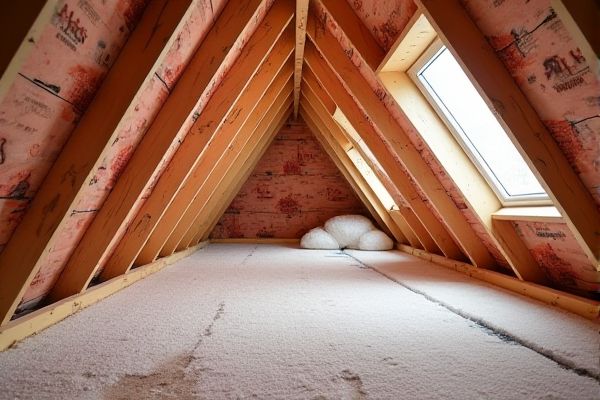
Batt insulation provides a solid, consistent barrier that fits between attic joists, offering good thermal resistance and ease of installation, while blown-in insulation fills irregular spaces and gaps more effectively, enhancing overall attic coverage. Learn more about which option suits your home's needs and how to maximize energy efficiency in your attic.
Table of Comparison
| Feature | Batt Insulation | Blown-In Insulation |
|---|---|---|
| Material | Fiberglass or Mineral Wool | Cellulose, Fiberglass, or Mineral Wool |
| Installation | Pre-cut panels fit between joists | Sprayed or blown into attic spaces |
| R-Value | Typically R-3 to R-4.3 per inch | Typically R-3.2 to R-3.8 per inch |
| Air Sealing | Less effective without additional air sealing | Fills gaps and voids for better air sealing |
| Installation Speed | Faster for straightforward spaces | Excellent for irregular or hard-to-reach spaces |
| Cost | Lower upfront material cost | Higher installation cost due to equipment |
| Durability | May sag or compress over time | Resists settling better, maintaining R-value longer |
| Best Use | Open, standard joist spacing attics | Irregular or hard-to-access attic areas |
Introduction to Attic Insulation Options
Batt insulation and blown-in insulation are two common attic insulation options that differ in installation and material composition. Batt insulation consists of pre-cut fiberglass or mineral wool panels, offering ease of installation and consistent thickness, while blown-in insulation involves loose-fill fibers such as cellulose or fiberglass that conform to irregular spaces for better coverage. Choosing the right insulation depends on attic accessibility, desired R-value, and budget considerations to optimize energy efficiency and thermal performance.
What Is Batt Insulation?
Batt insulation consists of pre-cut panels made from fiberglass, mineral wool, or natural fibers, designed to fit snugly between attic joists and wall studs. It offers consistent thickness and density, providing reliable thermal resistance (R-value) to help maintain your home's energy efficiency. Unlike blown-in insulation, batt insulation is easier to install in accessible areas but may leave gaps if not fitted precisely.
What Is Blown-In Insulation?
Blown-in insulation consists of loose fibers, often made from fiberglass, cellulose, or mineral wool, that are mechanically sprayed into attic spaces, creating a uniform thermal barrier. This type of insulation fills gaps and hard-to-reach areas more effectively than batt insulation, which comes in pre-cut panels that may leave seams and voids. Blown-in insulation offers superior air sealing and can be easily added to existing attic floors, improving overall energy efficiency.
Installation Process: Batt vs Blown-In
Batt insulation involves fitting pre-cut panels between attic joists, requiring precise measurements to avoid gaps and ensure a snug fit, which can be labor-intensive for irregular spaces. Blown-in insulation is installed using a machine that disperses loose fibers evenly across attic surfaces, allowing for quicker coverage and better conformity to odd angles and hard-to-reach areas. Your choice in installation process impacts labor time, material waste, and the overall effectiveness of attic insulation.
Energy Efficiency and R-Value Comparison
Batt insulation typically offers an R-value ranging from R-3.1 to R-3.4 per inch, providing consistent thermal resistance with easy installation between attic joists. Blown-in insulation, often made from cellulose or fiberglass, achieves higher coverage and can fill gaps and irregular spaces, resulting in improved energy efficiency by reducing air leaks and thermal bridging. The effective R-value of blown-in insulation can vary from R-3.2 to R-3.8 per inch, making it more versatile for maximizing attic insulation performance.
Cost Differences: Batt vs Blown-In Insulation
Batt insulation typically costs between $0.30 to $1.50 per square foot, making it a more affordable option for straightforward installations in attics with standard joist spacing. Blown-in insulation ranges from $1.00 to $2.00 per square foot due to the need for specialized equipment and labor, especially for irregular or hard-to-reach attic spaces. While batt insulation offers low upfront costs, blown-in insulation may provide better coverage and energy efficiency, potentially reducing long-term expenses despite the higher initial investment.
Air Sealing and Coverage Performance
Batt insulation offers limited air sealing due to gaps between the batts and framing, which can reduce overall energy efficiency. Blown-in insulation provides superior coverage performance by filling cavities and irregular spaces more completely, enhancing air sealing in your attic. This results in better thermal protection and reduced air leakage compared to batt insulation.
Soundproofing Capabilities
Batt insulation, typically made from fiberglass or mineral wool, offers effective soundproofing by absorbing airborne noise and reducing sound transmission between rooms. Blown-in insulation, such as cellulose or loose-fill fiberglass, fills gaps and cavities more completely, creating a denser barrier that can enhance sound dampening in attic spaces. For optimal soundproofing in attics, combining batt insulation with blown-in material maximizes noise reduction by leveraging the strengths of both insulation types.
Maintenance and Longevity
Batt insulation in attics requires occasional inspection for compression, moisture damage, and gaps to maintain its R-value, with a typical lifespan of 20-30 years depending on environmental conditions. Blown-in insulation offers superior longevity due to its ability to fill gaps uniformly, reducing air infiltration and settling over time, but periodic top-ups may be necessary every 10-15 years to maintain optimal thickness and efficiency. Both types benefit from proper ventilation and moisture control to extend performance and durability in attic applications.
Choosing the Right Insulation for Your Attic
Batt insulation offers a cost-effective, easy-to-install option with consistent thickness, ideal for standard attic joist spacing, while blown-in insulation excels at filling irregular or hard-to-reach spaces, providing superior coverage and air sealing. Your choice depends on attic geometry, existing insulation conditions, and desired R-value performance; combining both methods can also enhance thermal efficiency. Selecting the proper insulation improves energy savings, moisture control, and overall home comfort.
 homyna.com
homyna.com